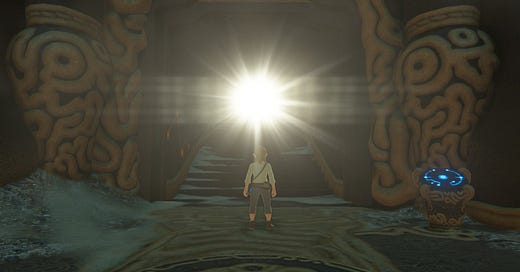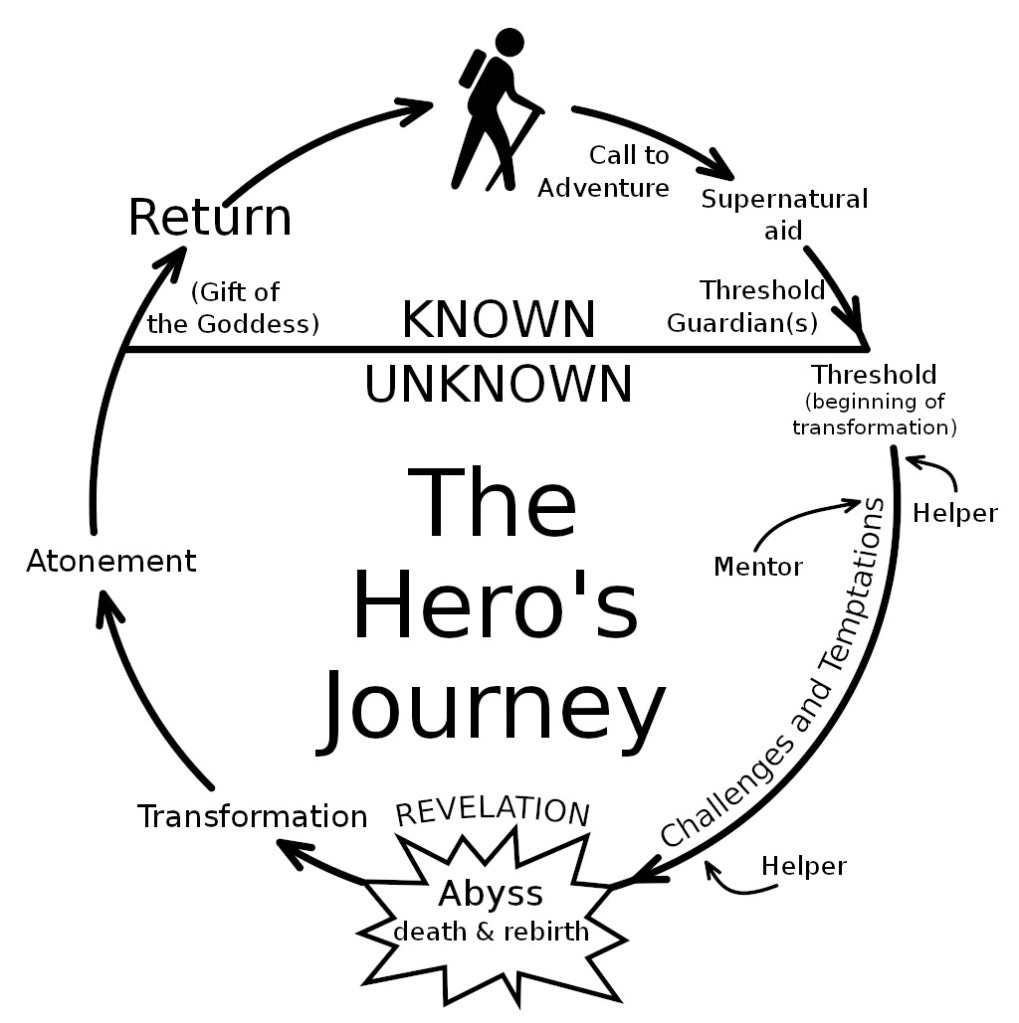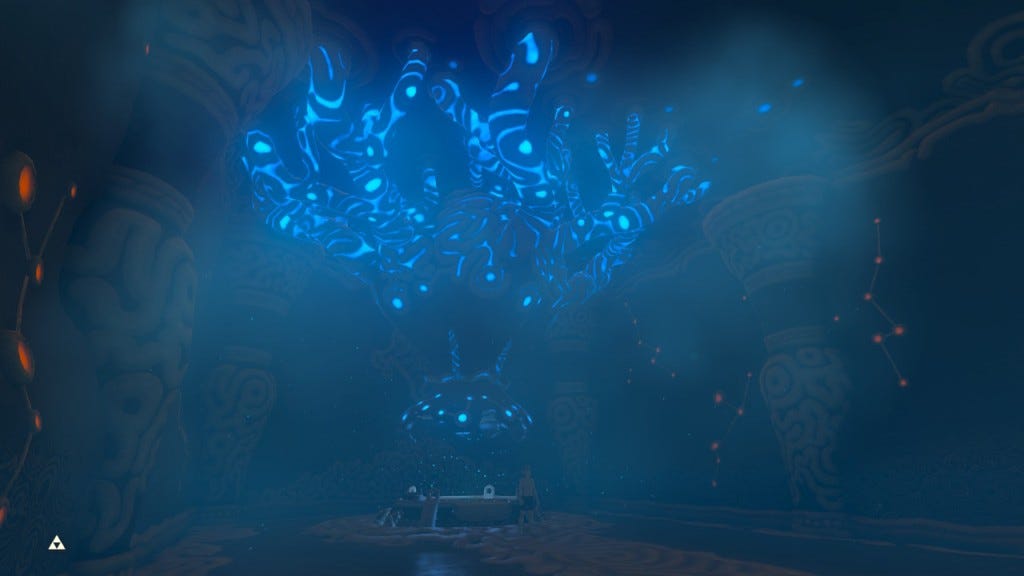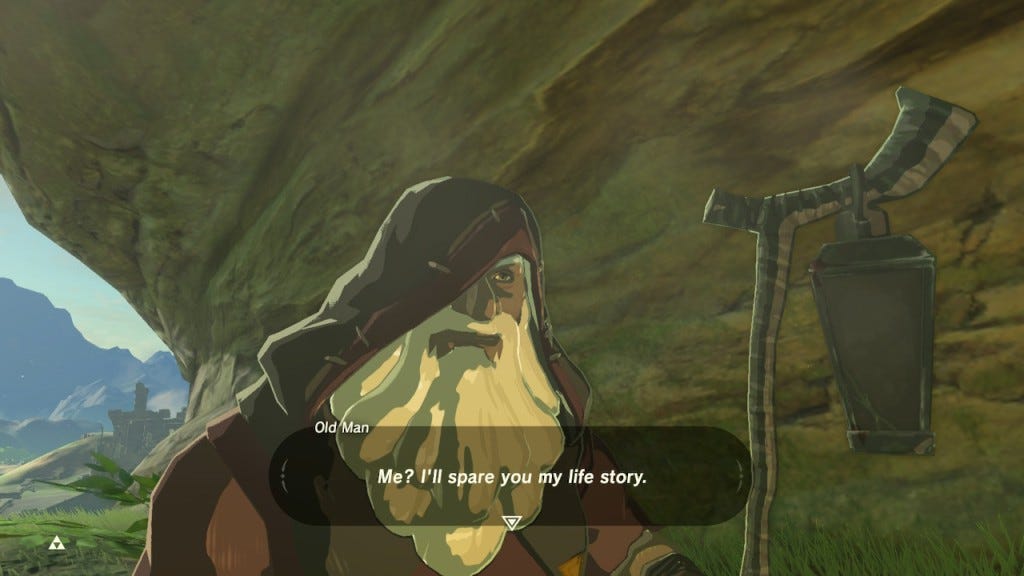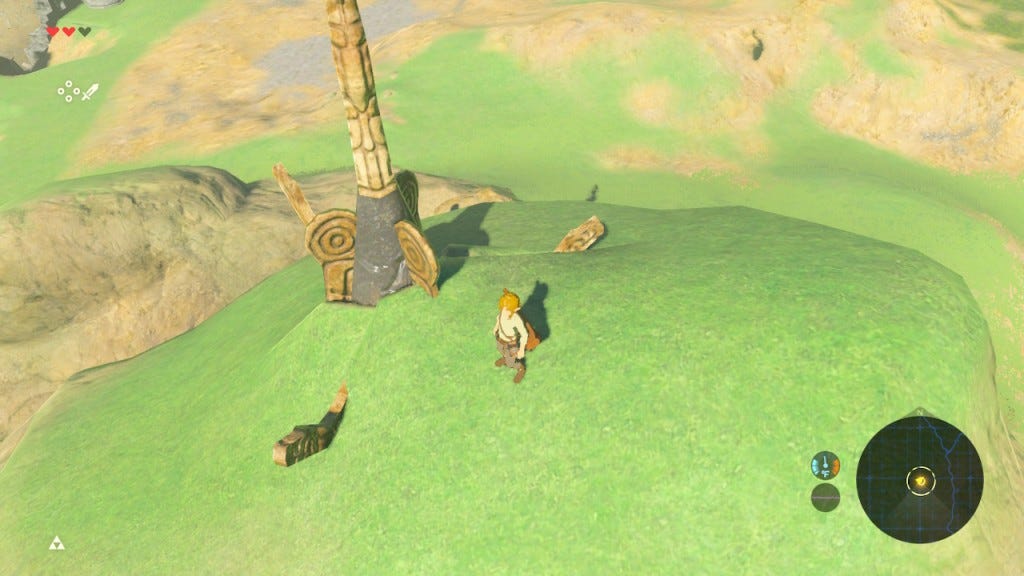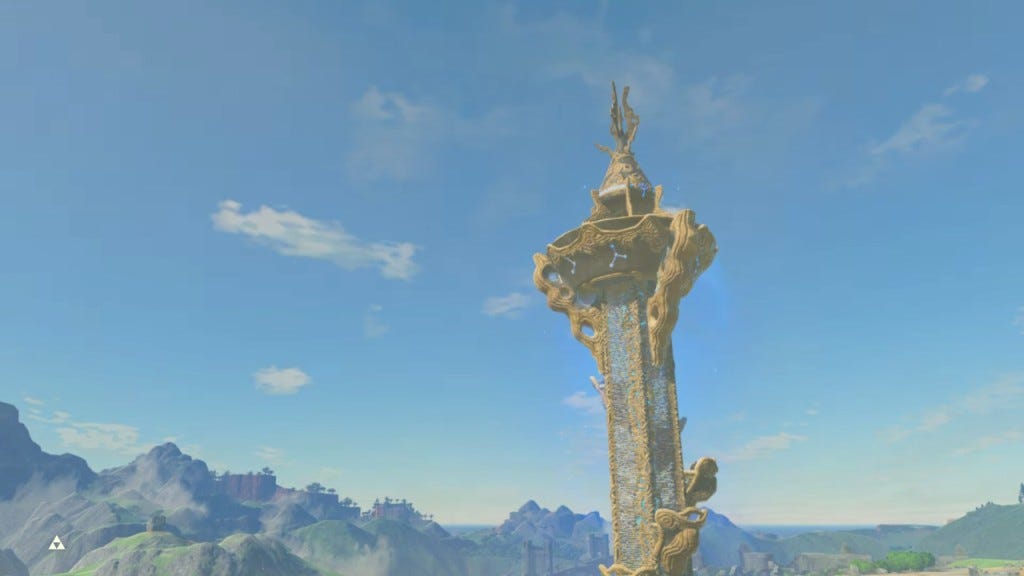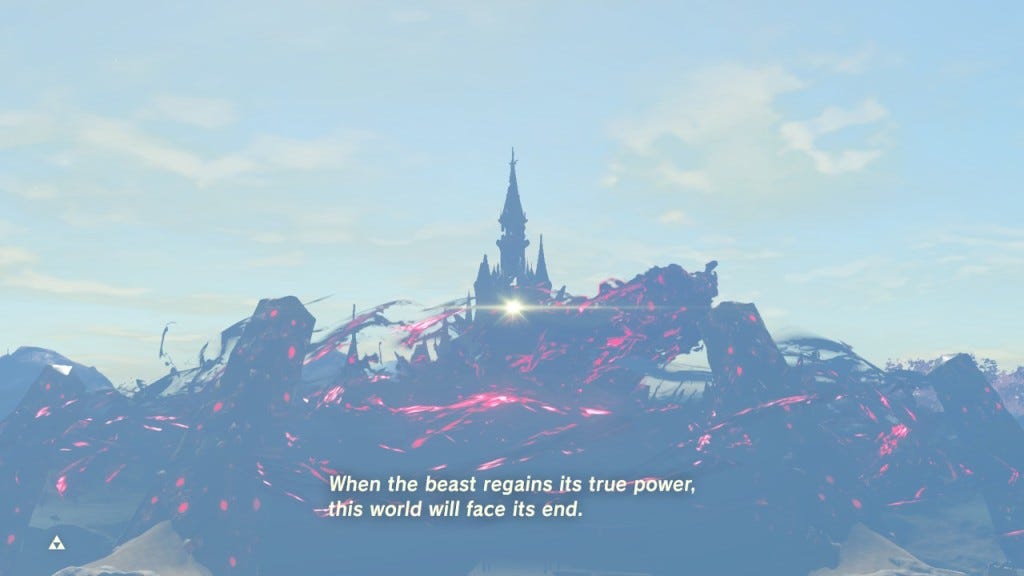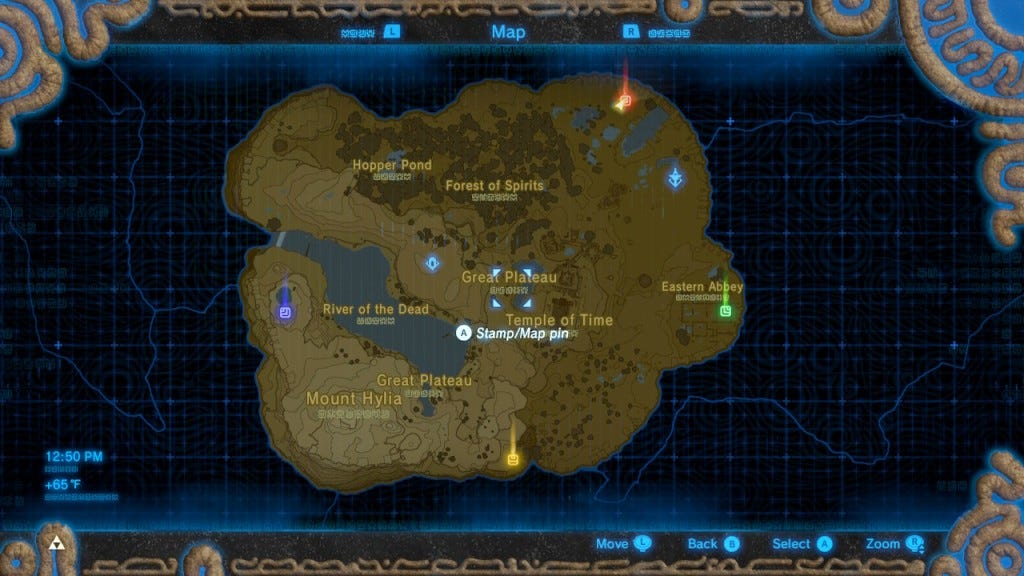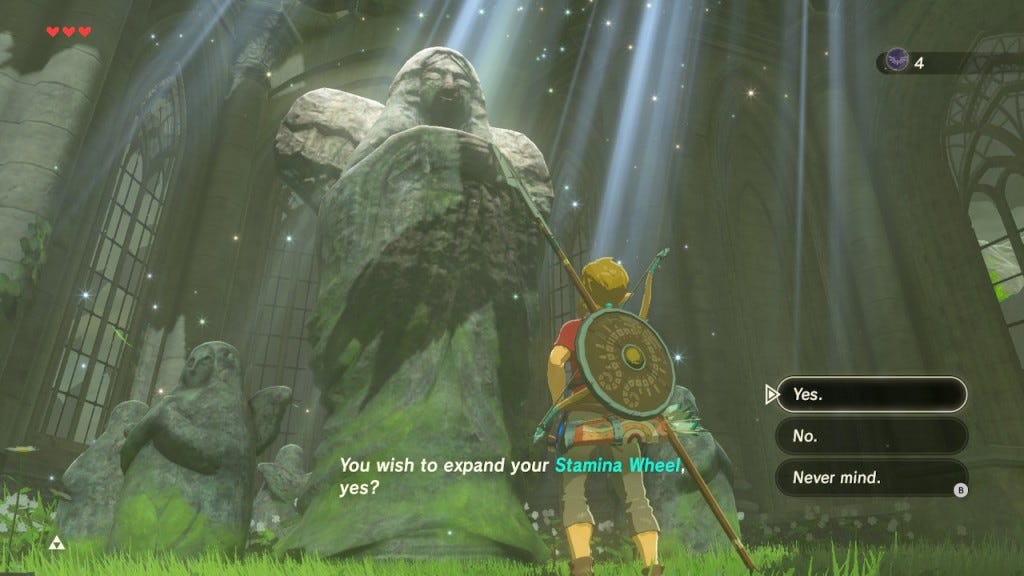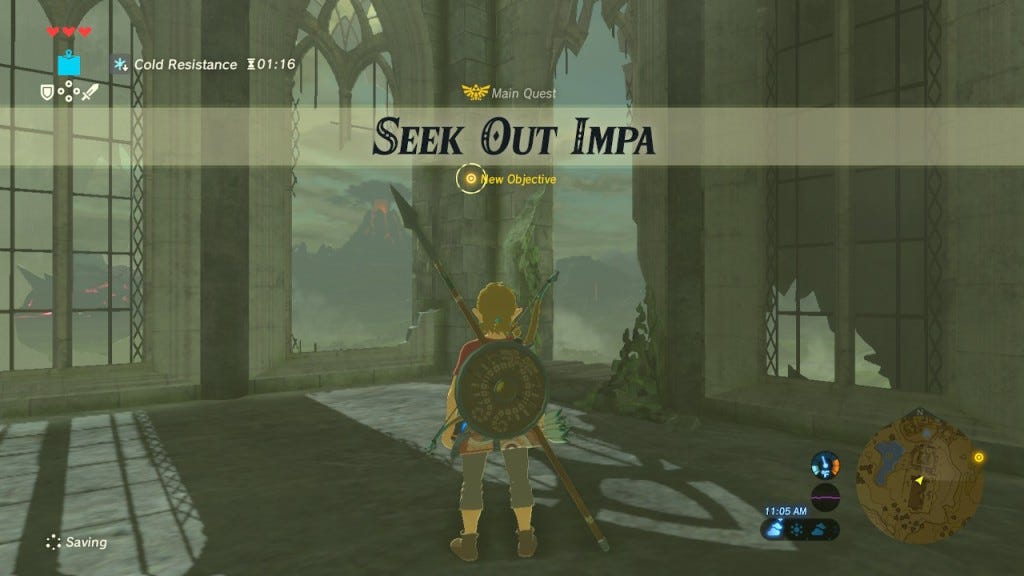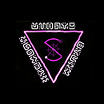What Child Is This? A Merry Zelda Yule
Introduction
Welcome to my first post that isn't a book review, and the first in what will be, for now, the other main category of posts on this blog. As I hinted at in my review for Don Webb's How to Become a Modern Magus: A Manual for Magicians of All Schools, I will be writing posts exploring the crossroads of video games and magic through the lens of an open world game. The general metaphor is one I've had incubating in mind for quite a while—the acorn of such an idea having been sown when I was 13 years old in the teachings of my Initiator into magic, germinated and nurtured through my spirit work over the years, and making its first appearance above the surface as a whole, fully-constituted sapling here in this post.
It was difficult at first to decide where and when to begin this exploration, but typically the best place to begin any journey is wherever you are. Today is Christmas Eve for those who observe non-Orthodox Christian holidays, but as is the custom throughout human history, many observances overlap at this time of the year known (to use a global term uncoupled from either hemisphere's seasons) as the South Solstice. For reasons that will become comically apparent, that makes it an opportune day to begin a brand-new playthrough of the game, The Legend of Zelda: Breath of the Wild to farm for material for this post.
Gather around the tree for this Yuletide tale...
'The Legend of Zelda' and The Hero's Journey
This section is probably worth its own post, and if I write one, I should remember to come back and link to it here. However, for now, I am going to assume the reader has some familiarity with Joseph Campbell and his work surrounding mythology. I don't think this is much of a stretch given Campbell's primary influence on popular culture through his mentorship of George Lucas. Among other things, the Star Wars Original Trilogy is a cinematographic expression of the Hero's Journey.
The most emotionally direct way I can come up with to relate the idea is to share the very moment it first struck me: The opening cutscene from an earlier installment in the blockbuster series, 2002's The Wind Waker. It took place long after the game was released (I am always behind the curve when it comes to playing consoles, and have typically been at least 1 generation behind in playing one myself). The sense was so palpable to me that this was being consciously done by the game creators that I shed genuine tears, sobbing by the end. "They're doing it," I thought to myself, "they're really doing it!" It came at a time when I was at a low point, consumed in depression. It was winter, as I recall, and snowy outside. I have mused in the past that it made me believe in magic again:
There are important truths in this story at the heart of The Hero's Journey and its purpose.
Nativity
Warning! SPOILERS for The Legend of Zelda: Breath of the Wild from here on out!
The Hero's Journey being a myth cycle, a question occurred to me even as I booted up the game this morning: Where, on the Wheel of the Year, is the best time to start? Again, I refer to the above answer of, "Wherever you are," but there are some standout options. Link, the hero and protagonist (despite this being Zelda's legend?), is a boy traditionally clad in green. At the opening of Breath of the Wild, we find him sleeping in a pod in a dark tomb. With the fertility suggested by the color green and the resonance of waking up in a tomb with the story of Jesus' resurrection, we might think along the lines of Easter/Ostara or whatever the Vernal Equinox is where you are, and that would be wholly appropriate here; since it's an open world game, we can do what we want.
However, since we're already "Linked" with Jesus (who, by the way, I have long looked up to as a model Magician, just so we're clear), we can use a birth metaphor, especially since the resurrection symbolism involved is a reification of root birth symbolism anyway. Regardless, our hero's coming out of a womb-like encasement.
Womb or tomb? Birth or resurrection? That's actually an important symbolic issue here because this is very clearly a game that is designed to be played through more than once. The experience of playing it for the first time is incomparable to any future playthrough and the context very much matters; however, it's nice that today is Christmas Eve because although I have played the game before, the lens of the "newborn babe" is most suitable for this post.
Besides (ah, the things you miss the first time around), I noticed this morning that the design of Link's pod closely resembles the root ball and trunk of a large tree (albeit inverted). Within this chamber rests also the very first item Link picks up, and it's the most important one: The Sheikah Slate; is this the "gift" at the bottom of the tree?
Taking the Sheikah Slate (which is basically a magical smartphone) and exiting the first chamber, Link finds some chests containing his first set of ragged clothes. After getting dressed, Link approaches another door and mentally hears a voice—we know it's the voice of Zelda, though he doesn't—calling out to him before he steps out into the light of day and onto The Great Plateau, his initial training ground. Link has been (re)born and has heard The Call to Adventure.
One reason I think this works just as well for a Winter Solstice symbol as it does for an Equinox symbol is that, as the light penetrates the tomb upon the door's opening, it also fades away soon after, reminding me of the way the light shines into the mound at Newgrange on the South Solstice:
The Great Plateau
Every open-world game worth playing must have a decent opening area. Now, I should be clear from the outset that I am not a hardcore gamer and so my standards for such things aren't as fine-tuned as those of many people. Nonetheless, I agree with the widespread opinion that The Great Plateau is one of the greatest opening areas of all time. It is a masterpiece and every single detail fits into a grand and meticulous picture. Even every word of dialogue is pregnant with meaning. As we will explore to varying degrees in different posts, the Great Plateau can be viewed as a hologram. To make my case, I'm going to point something out that I'll be coming back to, just past the tree branch that everyone picks up on their first playthrough: There are red-capped, speckled Hylian Shrooms growing at the feet of tall evergreen trees (more presents under more trees?)
Why is this "holographic?" It's going to take more than one post to explain fully, but it's because just look at the first human being Link meets upon emerging:
Who's that? That white-bearded man in the (dark, dark) red outfit? Santa?
Link talks to this man, who, depending on your dialogue choices and subsequent actions, teaches you a fair bit about the world around you and how to interact with it. Perhaps in a future post, I will get more granular and explore some of the Mysteries of his scripting (there is relevant detail at every single scale from which you view this game). We don't know it yet, but it turns out this is the arrival of Link's Supernatural Aid (I don't count Zelda because she's not strictly dead).
Soon, Link hears the voice of Zelda once more, and is charged to find his way to a specific point on the Plateau. He doesn't have to go straight there, or ever go there, but he won't be getting off of this plateau alive if he doesn't. Arriving at that spot, he finds a curious device poking out from the top of a hill. Down below, he finds a familiar-looking pedestal in which to insert his Sheikah Slate, and upon doing so, the buried apparatus activates, rises from the ground lit up in blue, and reveals itself to be a large spire called a Sheikah Tower. Simultaneously, 14 other towers across the Kingdom of Hyrule also activate and rise up from beneath the earth. These don't look like it, but they play into the emerging Solstice symbolism as well; they, too, are "trees" (that is, if you're doing a Winter Solstice run; a Vernal Equinox run would make this more of a "maypole" or something, I guess).
After this, Link must climb the tower, where he is contacted by Zelda one more time. His attention is directed toward Hyrule Castle, now shrouded in a vortex of inky, dark shadows we will come to know as "malice," or the very essence of hatred; Zelda reveals herself to Link as a point of light within the castle, holding this darkness named Calamity Ganon at bay, but letting Link know that he'll need to go in there and defeat said beast. This is why he was awakened from his sleep and, in a roundabout way, how he got there in the first place. I want to present this image because, having introduced the Hero's Journey theme, I have some strong opinions about its meaning. It will speak to certain viewers—some more loudly than others—from a very deep place in the unconscious:
Coming down from the tower, Link is called by the Old Man (with a very Santa-like "HOOO!"), who has rather creepily appeared at its foot. After re-stating the point Zelda had just made and asking him if he's going to go after Calamity Ganon, he offers Link something he'll need for his journey (another gift at the bottom of another tree?): A paraglider that will allow Link to glide down from the cliffs of the Great Plateau to the greater Kingdom of Hyrule (or, more accurately, its ruins) below. However, he isn't going to simply hand the paraglider over. He points out to Link that a nearby shrine has also started glowing, just like the towers. He tells Link that if he ventures into the Sheikah Shrine and retrieves the treasure within, he'll trade Link the paraglider for it.
In the shrine, in addition to the Spirit Orb the Old Man wanted him to get, Link also receives a special ability from another Sheikah Slate Terminal: The first of his "Runes" (well, that's an interesting name for them), a set of special abilities powered by the Sheikah Slate which Link will absolutely need if he is to succeed. This one is called "Magnesis," and it allows him to lift and move very large metallic objects effortlessly using magnetic force (I will cover the other Runes from the Great Plateau in a later post).
Emerging from the Sheikah Shrine, Link watches the Old Man glide down to his position out of nowhere again. Link hands him the Spirit Orb, but the Old Man reneges on his deal: Now he wants Link to go back to the top of the tower.
He can do that, but this is an open world game, and we just got a new toy. There are some metal treasure chests at the bottom of a pond right next to the Magnesis Shrine, that's convenient; oh, there's also a long, metal "plank." Lifting it up and bringing it over to a nearby pond, we see that we can use it to bridge the gap to a tree stump in the middle of the pond with two treasure chests resting on it. Well, look at that: Two more gifts, at the bottom of a felled tree. Wait, what's this? There's another tree positioned in the midground smack in the center between those chests? Okay, so there's a real tree for them to be under. It's also in between two other trees. Wow, it's almost as though the developers really wanted us thinking about trees as we opened up these chests, which contain, respectively, 5 Fire Arrows and 5 Ice Arrows.
Oh. My. God. Fire and Ice? Flanking a Tree? Is that...Yggdrasil? And if that's Yggdrasil, then that means the Old Man, or Santa, is...waitaminit, I have to recall a mental picture of him speaking to me. Aha! There's only one eye showing. I guess that about seals it; it's Odin! Remember those Hylian Shrooms? They look a lot like fly agaric, or amanita muscaria, about which I could tell you stories. I'll spare you.
The Great Plateau isn't just a hologram, it's a cosmological map in miniature; and that tower? Just as Yggdrasil is a localized example of the World Tree, so this tower, like other World Trees, is an "Axis Mundi" symbol.
At the top of the tower—to which Link can teleport using the Sheikah Slate—the Old Man points out the other shrines and teaches Link how to peer through the "scope" of his Sheikah Slate, target things like Sheikah Shrines in its sights, and mark them on his map (he now has a handy map of the Great Plateau, which was uploaded to the Sheikah Slate from the tower when he activated it). The Old Man has a new deal: Before he gives Link the paraglider, he wants the orbs from the three other Sheikah Shrines (each one grants Link additional Runes).
Now. This being an open world game, we can take them in any order we want. Technically, we could have blown the Old Man off and gone to a different one first. However (although this is not how I went about it on my first playthrough), looking at the map as well as the actual terrain from the lofty vantage point of the tower, we can see that a certain order clearly forms a "path of least resistance" that is especially appealing to a fresh new Link with only 3 hearts to his health meter, shitty clothes, and crude weapons: Starting from the Shrine at the Eastern Abbey (green marker as seen below), it just makes good sense to move from that one, clockwise around the Great Plateau to the next one in line upside a cliff (yellow marker), before getting the last one at the top of a sister peak to Mount Hylia (violet marker). Another name for this clockwise motion, since we're on the Solstice theme, is "sunwise" or "deosil." So, The Great Plateau is now a hologram, a cosmological map, and a Wheel of the Year. Nice!
Upon retrieving the 4th Orb, the Old Man appears once more and still won't give over the paraglider. This time, he wants Link to look at his map, draw imaginary lines connecting the 4 Shrines, and meet him at the spot where the imaginary lines intersect. I remember guessing the location at a glance, which is not a very special feat considering it's the Temple of Time, a ruined cathedral. Avid and longtime Zelda gamers will recognize this place as the very same Temple of Time that appears in the first 3D Zelda game for the Nintendo 64: The Legend of Zelda: The Ocarina of Time.
In this temple, taking center stage on the main altar on the ground floor is a statue of the Goddess Hylia, and it is positively glowing. Approaching it, Link hears the voice of Hylia, who takes note that Link possesses 4 Spirit Orbs. For these, she will trade him either an increase in health (1 Heart Container), or an increase in Stamina (1/5th of second Stamina Wheel to add to the full wheel he already has). We're going along with the established theme of “wheels” here and taking the Stamina increase.
The Old Man calls Link up to the top of the roof; well, would you look at that? We don't have a chimney nearby, but the next best thing is a church steeple (another tree/Axis Mundi) and Santa is standing there, ready to give us our Christmas gift now that we have attended "Midnight Mass."
He reveals his true identity as the deceased King Rhoam Bosphoramus Hyrule, Zelda's father, and, before finally ponying up with the damn paraglider, tells Link more of the story behind Ganon.
From here, Link finally gets to spread his wings and "fly," in a manner of speaking. It's a great big world and Link can go anywhere he damn well pleases, but the ghost of King Rhoam has strongly suggested Link head East, following the road through Dueling Peaks on the way to Kakariko Village to meet Impa, the Elder of the Sheikah Clan, who will give him further instruction. To reach this, an Eastern opening in the Temple of Time's steeple presents itself.
The other opening faces due North, staring right toward Hyrule Castle in the midground, the erupting edifice of the volcanic Death Mountain looming in the far distance.
Which way does Link go?
Let's not be in too big a hurry to meet our destiny, now. It's a big decision, being The Crossing of the First Threshold.


